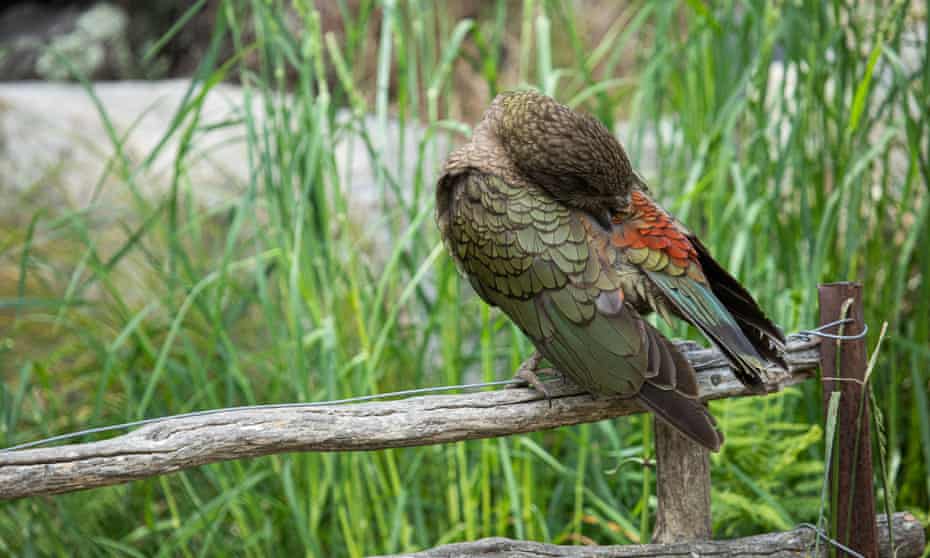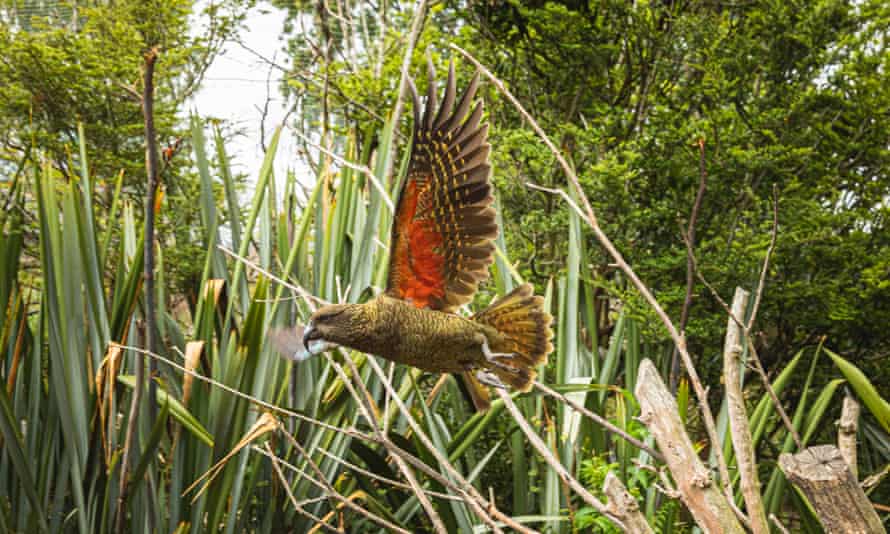‘He has adapted’: Bruce the disabled New Zealand parrot uses tools for preening
Alpine Kea with damaged beak teaches himself to use pebbles for grooming, in a first under scientific observation

Last modified on Fri 10 Sep 2021 07.21 EDT
Bruce, a disabled alpine parrot from New Zealand, may just be one of the most unique birds in the world. He comes from good stock – the Kea, the only alpine parrot, is considered to be among the most intelligent birds. When they aren’t dismantling tourists’ cars, stealing passports or occasionally killing sheep, they are known to weigh up probabilities to help them make choices.
But Bruce, who is missing the top part of his beak, has done something that has yet to be recorded anywhere else – he intentionally uses pebbles, in lieu of his beak, to preen himself.
Just as a human may scour the shop shelf for the right hairbrush, Bruce scratches about until he finds the perfect-sized pebble to dislodge mites and dirt hiding in his green and red plumage. Kea have been observed using tools such as sticks to disengage pest-traps, but what Bruce does is exceptional because it is the first evidence of tool use by a Kea for the purpose of self-care.
The study of Bruce, who is housed at the Willowbank Wildlife Reserve in Christchurch, has been published in the journal Scientific Reports. Although anecdotal reports exist for self-care tool use in pet parrots, this form of tool use is rare in the wild, the University of Auckland researchers say.

The report’s lead author, and PhD student at the university’s School of Psychology, is Amalia Bastos – a big Kea fan who has chosen to focus her research on the parrot because of their “massive personalities”.
What makes Bruce’s tool use more impressive, Bastos says, is that he did not have another bird to teach him – he figured it out on his own.
“Kea do not regularly display tool use in the wild, so to have an individual innovate tool use in response to his disability shows great flexibility in their intelligence,” she says. “They’re able to adapt and flexibly solve new problems as they emerge.”
Bruce was found at Arthur’s Pass in 2013, when he was still a juvenile, with the upper half of his beak missing. The researchers do not know how he sustained his injury, but it is thought to be the result of an accident with a pest trap. He was brought to the South Island wildlife hospital, where he was nursed back to health before settling into his current home.
Bastos describes Bruce as a bossy bird who knows what he wants. “He pushes the other birds around with his feet. He is doing quite well.”
His use of pebbles to preen was first noted by keepers at Willowbank in late 2019 and caught the attention of the researchers. “We needed to show that he was doing this intentionally,” Bastos says.
They set out to watch Bruce over nine days. There were five main observations that proved he was acting with intention: in over 90% of instances where Bruce picked up a pebble, he then used it to preen; in 95% of instances where Bruce dropped a pebble, he retrieved this pebble, or replaced it, in order to resume preening; Bruce selected pebbles of a specific size for preening rather than randomly sampling available pebbles in his environment; no other kea in his environment used pebbles for preening; and when other individuals did interact with stones, they used stones of different sizes to those Bruce preened with.

“Because Bruce’s behaviour is consistent and repeated, it is regarded as intentional and innovative,” Bastos says. “It is Bruce’s own unique tool-use, and this is the first scientific observation of that.”
Bruce has also devised a way to eat a range of foods, despite his disability. The keepers provide Bruce with soft foods, which could be eaten without an upper bill, but he has also learned to eat harder foods by pressing them up against hard objects.
“He’ll pick up a piece of carrot and push it against a hard piece of metal or rock and use that to scrape with his lower bill, which again is a feeding behaviour we haven’t seen in the other birds,” Bastos says. “It’s not tool use but it is another interesting way he has adapted to his disability.”

Bastos says it is important to examine rare behaviours like this through repeated observations to ensure accurate reporting. “This paper also provides a new framework through which we can provide robust evidence for rare behaviours.”
There are two main theories as to why Kea are particularly intelligent birds. The first, Bastos says, is that they are highly social, which requires more complex interaction. The second is that their feeding habits have had to adapt in harsh alpine environments, pushing them to innovate.
According to New Zealand’s Department of Conservation, Kea today are nationally endangered, with only about 3,000 to 7,000 birds remaining in the country.
